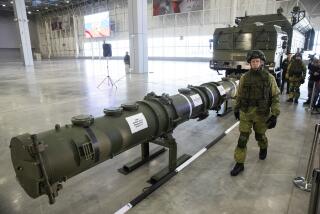Soviets Cheated on â72 Pact, U.S. Says : Arms Violation Charge Sparks Angry Denial
WASHINGTON â President Reagan on Wednesday accused the Soviet Union of violating the 1972 Anti-Ballistic Missile Treaty by moving two aging radar installations, touching off a round of superpower acrimony less than a week before his scheduled summit meeting with Soviet leader Mikhail S. Gorbachev.
Although Administration officials conceded that the equipment is not operational at its new location, Reagan said the deployment of any large radar outside recognized anti-ballistic missile sites constitutes at least a technical breach of the treaty.
âNo violations of a treaty can be considered to be a minor matter, nor can there be confidence in agreements if a country can pick and choose which provisions of an agreement it will comply with,â Reagan said in a report to Congress.
Kremlin Response
The Soviet Union launched a bitter counterattack even before the report was officially released. In Moscow, the chief Soviet arms negotiator, Viktor P. Karpov, said that the latest U.S. accusations were âapparently aimed at vitiating the atmosphereâ before Gorbachevâs arrival on Monday for his third summit meeting with Reagan.
In Washington, Soviet Gen. Nikolai F. Chervov called a press conference to respond to the charges. He said that Moscow had destroyed one of the radar units and dismantled the other.
Chervov also accused the United States of making new demands, which he said would make it more difficult to complete work on provisions of the intermediate-range nuclear forces treaty relating to verification.
The latest accusation of Soviet cheating seemed to be intended to reassure the Presidentâs conservative backers that Reagan maintains his long-stated skepticism of Soviet intentions, despite his meeting with Gorbachev, in which the two leaders are scheduled to sign the treaty banning ground-launched nuclear missiles with ranges of between 300 and 3,000 miles.
âThis is not a summit or a session to be taken lightly between old friends,â White House spokesman Marlin Fitzwater said. âThis is a summit between old enemies. We are working out a negotiated way to try to reduce what is a very real threat between the two countries.â
Fitzwater, responding to Soviet charges that the United States is trying to poison the atmosphere for the summit, said: âWe think the climate is entirely appropriate.â
Meanwhile, another pre-summit dispute seemed to evaporate. A senior Administration official said that Soviet data concerning intermediate-range missile deployments was turned over to U.S. officials in Geneva on Wednesday.
For weeks, the United States has been accusing the Soviets of withholding the information, which it said is required for verification of the new treaty. Officials had said that, if the Soviets did not supply the data before next week, the treaty might not be signed on schedule.
âWe got a data package today,â the senior official said, adding that it had not yet been examined.
Earlier in the day, State Department spokesman Charles Redman had said that the United States was withholding comparable information from the Soviets, although the U.S. package had been sent to Geneva so that it could be given to Soviet negotiators as soon as the Soviet information was received.
And even before that, Soviet spokesmen in Moscow and Geneva complained Wednesday about the U.S. failure to hand over the data.
The Presidentâs claim that the Soviets had violated the ABM treaty was contained in a report to Congress on Soviet compliance with all existing arms control treaties. Reagan said the Soviets had moved radars code-named âFlat Twinâ and âPawnshopâ from an ABM test range to an electronics plant in Gomel, about 300 miles southwest of Moscow. The report also reiterated earlier charges of other violations, most notably construction of a giant radar facility at Krasnoyarsk in Siberia.
Under the 1972 treaty, all ABM components, including radars, must be confined to a single operational ABM site or a single designated test facility. The purpose of the treaty is to prevent either nation from acquiring a defense of all its territory and thus gaining the confidence to launch a nuclear attack.
Such a nationwide missile defense is the objective of Reaganâs Strategic Defense Initiative. But work on that project has not proceeded far enough to constitute any treaty violation. Some U.S. officials have conceded that, if SDI ever reaches the stage of deployment, Washington will first have to renounce the ABM treaty.
âWhile it is not likely that the actions at Gomel are to support an ABM defense at that locality, deployment of such radars at Gomel to carry out any function is inconsistent with ABM treaty obligations,â the report said. âThis and other ABM-related Soviet activities suggest that the U.S.S.R. may be preparing an ABM defense of its national territory.â
In October, the Soviet Union offered to permit U.S. inspectors to visit the site. The United States agreed âin principleâ last month to accept the offer, although there is no agreement on the ground rules for the trip.
An Administration official said the United States is concerned that the Soviets might place such tight restrictions on what the Americans could see that it would make the inspection worthless.
For their part, Soviet officials insisted that they had not broken the treaty, and they said that a U.S. inspection would prove that.
âThe point at issue is, probably, the empty motor vans belonging to the Pawnshop radars, dismantled and destroyed in the Soviet Union, and individual fragments of the Flat Twin radars,â Karpov said, according to the official news agency Tass.
âAs to the Flat Twin radars, there are only individual fragments of radars of this type in the Gomel region, also used in the civilian economy, which in no way contradicts the ABM treaty,â Tass said.
The timing of the release of the report--five days before Gorbachevâs arrival in Washington--was perhaps more controversial than the contents of the document itself.
Congress requires the Administration to issue such a report each Dec. 1. But that deadline had been allowed to slip in the past. For instance, the 1985 report did not reach Congress until Dec. 23.
Staff writer William J. Eaton in Moscow contributed to this article.
More to Read
Get the L.A. Times Politics newsletter
Deeply reported insights into legislation, politics and policy from Sacramento, Washington and beyond. In your inbox three times per week.
You may occasionally receive promotional content from the Los Angeles Times.










